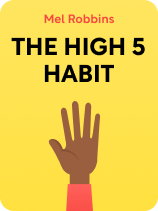

This article is an excerpt from the Shortform book guide to "The High 5 Habit" by Mel Robbins. Shortform has the world's best summaries and analyses of books you should be reading.
Like this article? Sign up for a free trial here.
What is the High 5 Habit? How does your brain respond to this self-improvement habit?
In the book of the same name, Mel Robbins describes the High 5 Habit as a practice that can boost your confidence, amplify your positivity, and propel you toward your goals. It’s a game-changing technique that will revolutionize your relationship with yourself.
Keep reading to learn more about the High 5 Habit and why it’s a recommended practice.
What Is the High 5 Habit?
What is the High 5 Habit? It’s a daily attitude of self-love that boosts your confidence, happiness, and ability to achieve your goals. Robbins explains that while many of us enthusiastically cheer on our partners, children, and colleagues, we often fail to be cheerleaders for ourselves. Instead, we hold onto self-limiting beliefs that prevent us from achieving our dreams. She argues that you can change your mindset by starting your day with a high five instead of with self-criticism and doubt. A high five, she insists, is the best way to communicate to yourself that you’re worthy, loved, and capable of achieving your biggest dreams.
(Shortform note: The scientific term for self-love is self-positivity bias, a cognitive bias where people demonstrate a largely favorable view of themselves, emphasizing their strengths and attributes over their weaknesses. Some psychologists suggest that self-positivity bias has a number of evidence-based mental and physical health benefits, including lower stress levels and increased confidence and motivation. However, this bias also has the potential to hinder self-awareness and lead to overconfidence or an unrealistic assessment of one’s own abilities.)
Why Does the High 5 Habit Work?
Robbins explains that thanks to a part of your brain called the Reticular Activating System (RAS), what you pay attention to determines your reality. According to Robins, the RAS acts like a filter for the brain, deciding which information gets into your conscious awareness and which gets ignored. It works to prioritize what you find relevant or meaningful. Therefore, if you think negative things about yourself, you’re telling your brain that this information is important, and the RAS will prioritize the information that reinforces that belief.
(Shortform note: Robbins offers a simplified explanation of the RAS, focusing on its role as a filter that decides which sensory signals are important and should be processed by the brain. However, the RAS serves multiple functions within the body. Its primary role is to regulate the sleep-wake cycle and control our level of consciousness.)
According to Robbins, your RAS is designed to work for you. If you go through your day focused on all the ways you’re not good enough, you’re likely to find evidence that supports this belief, reinforcing your negative self-image. But the opposite is also true. Robbins suggests that by consciously directing your attention and focus toward your own strengths and opportunities, you can change the kind of information that gets filtered through to your conscious brain. This is where a daily high five comes in. By starting your day with a high five, you’re taking the first step to retrain your brain to focus on your limitless potential rather than your perceived failings.
(Shortform note: Many life coaches and self-help experts agree that retraining your RAS is an effective tool to transform your life. Despite a lack of scientific evidence supporting this claim, anecdotal evidence suggests the practice can be empowering. For example, some entrepreneurs attribute their success to their ability to take advantage of their RAS.)
Why a High Five?
There are a number of ways to refocus your attention on your strengths instead of your weaknesses, but Robbins advocates for the power of the high five. Research suggests that high fives are a particularly effective tool to increase confidence and build trust. She references one study exploring the best way to motivate school-age kids. Kids who received a high five (as compared to praise for their skill or work ethic) felt higher levels of self-esteem and showed greater perseverance. Robbins argues this is because a high five, unlike many other forms of praise, celebrates the person, not their ability or even their effort. So when you give yourself a high five, you’re communicating confidence and trust in yourself.
Robbins suggests that by giving yourself a high five and engaging in positive self-affirmation, you can create a positive association with your reflection in the mirror. This act helps to establish new neural pathways in your brain, forming connections between neurons that enhance the flow of information. These reinforced neural connections can contribute to a more positive mindset and self-perception, supporting personal growth and a greater sense of self-confidence.
Citing the research of neurobiologist Lawrence Katz, Robbins explains how high-fiving yourself is an example of a neurobic exercise, an exercise specifically designed to challenge and stimulate different parts of your brain. These exercises often involve performing activities in new and unconventional ways. Robbins argues that giving yourself a high five in the mirror is an unexpected action that puts your brain on high alert. Then, because of the positive associations of high fives built up over years, your brain starts connecting those positive feelings with the image of yourself in the mirror, triggering a shift in perspective that allows you to think about yourself in a new, and more positive, light.

———End of Preview———
Like what you just read? Read the rest of the world's best book summary and analysis of Mel Robbins's "The High 5 Habit" at Shortform.
Here's what you'll find in our full The High 5 Habit summary:
- Why you should start each day by giving your reflection a high five
- How to silence self-doubt and adopt an attitude of confidence and self-love
- The psychology behind why high fives make you feel good






